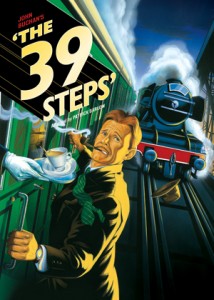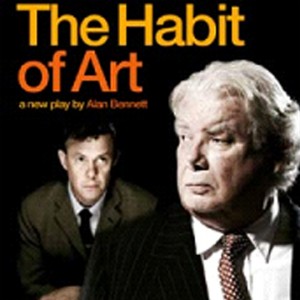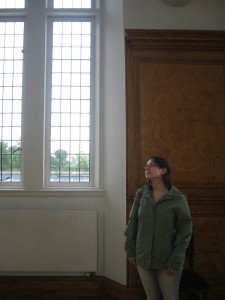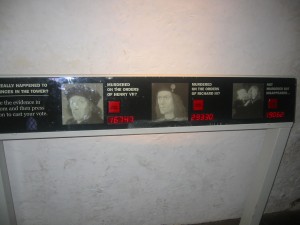September 19th, 2010 · 1 Comment
I have now seen a total of five shows here in London. First, the Merry Wives of Windsor at the Globe Theatre, followed by the Czech Philharmonic concert at Royal Albert Hall, Les Miserables at the Queen’s Theatre, The 39 Steps at the Criterion Theatre, and The Habit of Art at the National Theatre. For this blog post, I will focus on The 39 Steps and The Habit of Art, because I think these shows have certain things in common that are a good demonstration of British culture.
Both shows were distinctly meta-theatrical. In The 39 Steps, costume and set changes happened right on stage and Professor Jordan proclaims the show’s self-consciousness when he is shot by a bodiless arm at the end of the show and shouts “This is supposed to be a four person cast!” The Habit of Art is a play within a play. Better yet, the play within the play is being rehearsed at the National Theatre, where the play is being shown. The rehearsal of Caliban’s Day is frequently interrupted by the actors, the stage manager, and the writer to talk about the trials and tribulations of acting, writing, and theatre. I think that both of these shows’ use of meta-theatre demonstrates the British love of irony and humor, their tendency toward self-consciousness and self-deprecation, and the Importance of Not Being Earnest Rule as defined by Kate Fox. Meta-theatre demonstrates that the show and the playwright are not taking themselves too seriously. When some of the class was talking during intermission, I remember Matt wondering why there couldn’t have just been a play about Auden and Britton, and why they had to go to the trouble of adding all the extra characters and putting it in a frame. He suggested that the playwright was too worried that a serious play about Auden and Britton would not go over well. This theory may be exactly right. A play just about Auden and Britton may have been reviewed with an “Oh come off it” rather than a “deeply and unexpectedly moving” and a “I can think of few plays that combine wild laughter, deep emotion, and technical ingenuity with such bravura” (Charles Spencer, Telegraph, 18 November 2009).

photo credit: Google Images

photo credit: Google Images
This is still just a theory. As a sidenote, I do think the framing had its merits. Caliban’s Day is about the pressure to create art, the artist’s consciousness of his role and reputation as an artist, and the contriving that goes on behind the scenes with the artist’s fear of biographical information seeping into or being read into his art. The insecure actors and writer and the ever-comforting and conciliatory stage manager are a parallel story to Auden’s and Britton’s, allowing the themes to be developed more deeply and thoroughly, applying them to theatre as well as poetry and music.
We have talked about theatre in London as being a sort of equalizer. Anyone who can afford even fifteen pounds can get a pretty good seat for a show. In the National Theatre, there are no restricted view seats nor are there any boxes. Everyone is on the same footing, and to demonstrate this, we got to sit in the same row as Sir Ian McKellen at The Habit of Art. While all of this is true, I still felt like a bit of an outsider at both of these shows. I really enjoyed The 39 Steps, but I still had some trouble catching all of the jokes, even after having read Fox and lived in London for a month. Many of the jokes, such as the jokes about Welsh politics and the “sorry, sorry, sorry” sequence on the train are distinctly British, and not fully accessible to us foreigners. The same held true with the humor in The Habit of Art. I’m not complaining; I’m sure American movies and plays present the same problems to the British. I do think I have a point though, in saying that the content in The Habit of Art was not accessible to just anyone. I think in order to fully understand the play, you needed a reasonable understanding of theatre and its operations (in this respect our backstage tour helped a lot) and an understanding of Auden’s biography, his poetry and The Tempest. It took me probably until close to intermission to grasp who all the characters were and the plotlines of both stories. I think the play was rather intellectual, despite containing much crude humor, and perhaps did not quite match the humble and universally accessible National Theatre.
Tags: 2010 Kaitlin
September 19th, 2010 · 6 Comments
Thanks to so many of you for asking about my experience at Pope Benedict XVI’s prayer vigil in Hyde Park yesterday afternoon. It was profoundly renewing spiritually and I’ll remember it for the rest of my life. I don’t want to get boring, soap-box-y, or too personal, so I’ll leave it at that.
But I would like to start a discussion, if anyone’s willing, about the controversy surrounding the Pope’s visit. I think this was a bit of a missed opportunity in class – the past few days have been historic, marking the Holy See’s first-ever state visit to the UK, first visit of any kind in 28 years, and perhaps most importantly, the beatification of Cardinal John Henry Newman, an Christian theologian from the Victorian Era and an important English figure, historically, intellectually, and religiously. (The beatification – or the penultimate step on the road to sainthood – of Cardinal Newman has taken a kind of backseat to the “state visit” thing. Actually, Newman is the main reason for the Pope’s visit. To learn more about the Cardinal – and why he’s so important to England and to the Church – read here: http://www.thepapalvisit.org.uk/Cardinal-Newman)
The visit’s official theme – “Heart Speaks Unto Heart” – comes from the writings of Cardinal Newman. Although Newman was a theologian and a professor at Oxford, he recognized the importance of faith deeply felt. He found in the Catholic Church what he considered to be a perfect union of intellect and spirit, mind and heart. You can probably guess why Benedict wanted to emphasize this aspect of Newman’s life to believers in England- we’ve spent plenty of time talking about how secular today’s England is. In his homily at Hyde Park, in front of an estimated 80,000 he encouraged Christians to join with Newman and “radiate” faith rather than just accepting it intellectually. He also recognized that believers in England fight a bit of an uphill battle as they try to live their faith in a nation that wants little to do with faith. The Guardian reported quite fairly, in my opinion, on the Hyde Park vigil here: http://www.guardian.co.uk/world/2010/sep/18/pope-benedict-hyde-park-speech

Waiting for Benedict in Hyde Park (personal photo)
What I’m driving at is that, in my experience, the Papal visit was tailored very carefully to fit the English character. The visit reflected a lot of what we’ve talked about in class, actually. He wanted to address secularism as well as a long history of religious strife – the altar at Hyde Park was set up, intentionally, very close to Tyburn, where Protestants and Catholics alike have been martyred. Benedict also, at other times during his visit, addressed the British tendency toward moderation – reminding them, essentially, to be moderate in moderation. He paid homage to the 70th anniversary of the Battle of Britain – pointing out that he was a child during the dark days of Nazi Germany, and expressing his gratitude for the sacrifices of British servicemen and women.
I mentioned the controversy surrounding the visit a little earlier, though. Although I’m sure most of us noticed the Scientologists protesting in their Guy Fawkes masks – a little paradoxically, considering that Guy Fawkes was Catholic, or maybe that’s the point – the main group protesting the visit is called Protest the Pope. Their official website contains a list of grievances against the state visit of Benedict XVI: http://www.protest-the-pope.org.uk/ Although they claim that 20,000 protesters came out to support their cause yesterday, the police can’t confirm that number and neither can I – really, I don’t know where all those people were hiding because we certainly didn’t notice them.
For me, at least, Protest the Pope’s arguments are flimsy. They’re essentially saying the Pope can’t have a state visit because he’s Catholic, as far as I can tell. And it seems to me that when 17.5% of your country accepts the moral authority of one person, the government has a vested interest in a good relationship with that person. Not to mention that the Holy See is an ally for the UK government on matters of worldwide poverty, healthcare, and education, of climate change and sustainability, of nuclear disarmament and peace.
There’s one last aspect to the religious controversy surrounding this visit: six Muslims were arrested in connection with an alleged plot to assassinate the Pope. Here’s some more information on that: http://www.telegraph.co.uk/news/newstopics/religion/the-pope/8010002/Pope-visit-sixth-man-arrested-over-alleged-assassination-plot.html. The men have been released without charges. But I can’t help but wonder how this will affect Britain’s religious climate as well. Until these arrests, the conflict was between Catholics and secularists. Now, there’s a whole new dimension. Will the Muslim community react with anger and outrage? Will some Catholics resort to discrimination and hate? Will the whole story be forgotten by tomorrow? It will be interesting to watch this unfold.
Sorry for the length of the post – I just wanted to give some background on the visit and see if anyone has thoughts to share. I think this would be a good space to have a respectful dialogue about the place of religion in the British government.
Tags: 2010 MaryKate
September 19th, 2010 · No Comments
I’ve said this before but I’ll say it again, in case anyone has missed it: I’m a huge Anglophile. If it’s English, it’s pretty much guaranteed that I’ll love it. Coming to the UK has literally been the fulfillment of a lifelong dream. A huge part of why that is lies in the museums it has to offer.
As an English major specialising in 19th Century British Literature and a Medieval & Early Modern Studies Major focusing on Shakespeare and the history of the Tudor dynasty, I’ve been most excited about the museums whose collections have items specifically to do with my areas of interest. These are not always the ones you would think: for example, the British Museum turned out to be somewhat disappointing to me [not to discount its quality or credit at all: I mean, the Rosetta stone was pretty damn cool, as were the Lamassus that I studied in my summer art history course and then got to see in the flesh . . . errr, in the stone?] but the highlight of my visit was the following:

a bust of Shakespeare
and 
Engravings of Henry VIII
[all photos, unless otherwise mentioned are personal]
Disappointing, no? I thought so.
On the other hand, I was magnificently surprised by the museums we visited in Greenwich. Having no interest in science whatsoever, I thoroughly enjoyed walking around the Greenwich Observatory, particularly the Octagonal (?) Room:
 The Queen’s House too was a lovely surprise. Unfortunately, I left my camera in my bag which I checked when we came in, but imagine this scenario:
The Queen’s House too was a lovely surprise. Unfortunately, I left my camera in my bag which I checked when we came in, but imagine this scenario:
Elizabeth has somewhat unwillingly accompanied her friends into the Queen’s House. No sooner does she enter the first gallery but with whom does she come face to face?
 That’s right. My good buddy Henry the Eighth (photo courtesy: http://www.nmm.ac.uk/visit/exhibitions/on-display/the-tudors-at-greenwich-gallery)
That’s right. My good buddy Henry the Eighth (photo courtesy: http://www.nmm.ac.uk/visit/exhibitions/on-display/the-tudors-at-greenwich-gallery)
I enjoyed the Museum of London and the Docklands Museum too but (as I later discovered) because I had picked up some sort of stomach flu, I wasn’t really in the best state of mind to appreciate them fully. I plan to revisit the Museum of London tomorrow – if I’m up to it, for now I’ve got some weird ear, nose and throat infection – and take lots of photos (I had my camera with me when we went as a class, but it decided to die halfway through the Plague presentation). I particularly enjoyed looking at their Vauxhall Gardens presentation and the recreation of Dickens’ London.
I have already expressed my opinions of the National Portrait Gallery elsewhere (http://blogs.dickinson.edu/norwichhumanities/2010/09/national-portrait-gallery-my-two-pence/) but will emphasise again the sheer joy I experienced seeing up close and personal paintings that I’ve looked at in textbooks countless times, particularly this one:
 [Elizabeth I coronation portrait- http://www.npg.org.uk/collections/search/portrait/mw02070/Queen-Elizabeth-I?sText=queen+elizabeth&submitSearchTerm_x=0&submitSearchTerm_y=0&search=ss&OConly=true&firstRun=true&LinkID=mp01452&role=sit&rNo=2)
[Elizabeth I coronation portrait- http://www.npg.org.uk/collections/search/portrait/mw02070/Queen-Elizabeth-I?sText=queen+elizabeth&submitSearchTerm_x=0&submitSearchTerm_y=0&search=ss&OConly=true&firstRun=true&LinkID=mp01452&role=sit&rNo=2)
I’m uncertain whether or not to call our visits to places like Stonehenge, Wesminster Abbey, the Tower of London, or the Roman Baths (in Bath) “museum visits” but, while I had a tremendous time at all of this sites HUGELY significant to my areas of interest, I couldn’t help but notice that they had been “tourist-ized.” Case in point: at the Tower of London, as you look at the stairs where the bones of the two murdered Princes (http://en.wikipedia.org/wiki/Princes_in_the_tower) were supposedly found, you would hear sound effects on a loop which included such gems as “Mother! Where are you?” and “I thought I was supposed to be king.” This made it feel more like Disneyland and the walkthrough of Sleeping Beauty’s Castle than anything else I’ve seen here so far. Also, they look “interactive displays” perhaps a bit too far:
 Yes. An electronic counter which allows visitors to vote on who they think murdered the princes. Besides the sheer cheesiness of this attraction, I’m quite irritated to see that Richard III is still getting the rotten end of the stick. Our dear tour guide John agrees with me on this!
Yes. An electronic counter which allows visitors to vote on who they think murdered the princes. Besides the sheer cheesiness of this attraction, I’m quite irritated to see that Richard III is still getting the rotten end of the stick. Our dear tour guide John agrees with me on this!
Beyond the sometimes-unbearably touristy nature of the Tower’s displays, it was still incredible to stand in the buildings where so much history – history that is of particular interest to me – went down.
I’ve gone to quite a few museums by myself as well. Much as I love our group, sometime it’s nice to go at your own pace or go somewhere that not everyone would want to go. Holly and I experienced this in our visit to the Jane Austen Centre in Bath which, for us, having taken English 399 with Professor Moffat on Austen, didn’t really contain anything we didn’t already know (thanks, Moffat!) but was good fun nonetheless:

On one of our free days, I hit two museums I particularly wanted to see: the Tate Britain (NOT the Tate Modern *shudder*) and the Queen’s Gallery at Buckingham Palace.
First of all, I wanted to see the Tate specifically for a portrait of Elizabeth I that I had read was in their collection which, upon visiting, I discovered was either an error on my part or had been taken off display. Nevertheless, I enjoyed wandering around the galleries, particularly when I came across these two pictures, side by side:


On the top, “Ophelia” by Sir John Everett Millais and “The Lady of Shallot” by John William Waterhouse on the bottom.
Both of these paintings are iconic to me and a print of the “Ophelia” adorns the door to my bedroom at home.
As for the Queen’s Gallery, I was thrilled to go for several reasons. First, I wanted to see Buckingham Palace without being a total tourist about it. Second, the current exhibition was entitled Victoria and Albert: Art and Love and I think Victoria and Albert have one of the sweetest love stories in history.

Third and most important, one of the core components of the exhibition was works by Franz Xaver Winterhalter, my ALL TIME FAVOURITE artist, a court portrait painter who painted at least 120 works for Victoria and her family. Again, the special joy here was seeing up close and personal works that I have previously drooled over in textbook or digital format, such as these two :
:
 Victoria and Albert, by Winterhalter.
Victoria and Albert, by Winterhalter.
From the Royal Collection (http://www.royalcollection.org.uk/microsites/vanda/MicroSection.asp?themeid=841)
This is, obviously, not a final account of my museum experiences in London and England as a whole. I fully expect to enjoy more in the next few days (hopefully, if I can get myself feeling better) and many repeat visits over the course of the year.
Tags: 2010 Elizabeth · Museums
September 19th, 2010 · 5 Comments
In the last month, I have seen Merry Wives of Windsor, Bedlam, Les Miserables, 39 Steps, and The Habit of Art, which is significantly more theater in a very short time than I’ve been able to see in the US. So that being said, I have to get my initial gushing about how excited I am that I’ve had this great opportunity and how it’s really great that London makes its arts so cheap to attend and accessible to the public. I say this mostly because I’m genuinely thrilled. I really can’t get over how awesome it is that I get to see all this stuff as part of a class for really cheap. I think that although Kate Fox talks about the English egalitarian sentiment as a largely hypocritical façade for a very unequal class system, the English really do an amazing job of making beauty accessible to everyone – free museums, cheap theater, beautiful parks, etc. (I also say this because my mom keeps reading my Dickinson blog – hi Mom! – and it’s a super cranky blog because American Studies has trained me that when I analyze, I must be angry and critical of society). But anyway, everyone has already talked about the accessibility of beauty. So I’m going to do the other thing that American Studies has trained me for: talk about something inappropriate and pretend it’s academic.
Today’s topic is cross-dressing. Out of all the plays I’ve seen, Les Mis was the only one that did not contain a prominent cross dressing scene, and it’s not English in origin. Bedlam was so intent on having a cross-dressing scene that it didn’t even matter that there was no explanation for it in the plot. The Habit of Art was not even a comedy, and it still had a cross-dressing scene. What part of the English psyche demands a man in drag so intently that it has become a staple of theater?
Kate Fox would probably say it’s the “importance of not being earnest,” the idea that one must never take oneself too seriously (62, 63). Serious plays must be offset by something self-deprecating and silly, and comedies must contain some form of low brow humor to offset the perception that the jokes are too high and pleased with themselves. (American Studies Jesse would at this point start discussing: 1. The sexism in the idea that a man in drag is funnier and more self-deprecating than a woman in drag because women are less valued in society. 2. The classism in the language of “high brow” and “low brow” and how it creates a humor hierarchy that perpetuates class stereotypes about intelligence and arrogance. But American Studies Jesse is going back into her angry-at-society box now, away from this discussion).
What Kate Fox does not address, is why the “importance of not being earnest” specifically manifests itself in the form of men in dresses and stockings. Sexism and classism are not exclusive to England, and they’re too easy an answer. One of my theories has to do with Liz’s favorite topic, Shakespeare. Shakespeare seems to be a huge point of national pride for the English, and his plays contained a lot of cross dressing for comedic purposes, plot purposes (i.e. The Twelfth Night), and for the practical purpose that only men used to act so they would have to play women’s parts. Maybe the influence of Shakespeare has seeped its way into modern theater in the form of cross dressing. I definitely think at least Leyshon felt some pressure to write some Shakespearean humor into Bedlam since it was performed at the Globe.
My other theory has to do with the absolute silliness of the men’s outfits that we saw in National Portrait Gallery. We look upon the tights, lacy and velvety frills and fabrics, codpieces, and otherwise ridiculous jewelry of the upper class men from the Tudor and Stewart line with the same out of context amusement that we see in the stupid haircuts of cool kids in our parents undoubtedly see in skinny jean leggings. Maybe the history men’s fashion, some of which is totally effeminate by today’s standards, has affected theater. Every time an English person see a man in a dress and suspenders maybe it hearkens back to the old days of the monarchy and the glory of the empire. (Fun fact: Vicky taught me yesterday that in England, suspenders are those little clasps that women use to hold their stockings up rather than straps that old people and people that enjoy ska music use to hold up their pants).
For more information on cross-dressing in theater, here is an article from the Guardian: http://www.guardian.co.uk/stage/theatreblog/2007/sep/07/whatilikeaboutcrossdressin
I welcome any other ideas.
P.S. Mom, England is very fun and educational and full non drag queen related learning experiences.
Tags: 2010 Jesse








 [Elizabeth I coronation portrait- http://www.npg.org.uk/collections/search/portrait/mw02070/Queen-Elizabeth-I?sText=queen+elizabeth&submitSearchTerm_x=0&submitSearchTerm_y=0&search=ss&OConly=true&firstRun=true&LinkID=mp01452&role=sit&rNo=2)
[Elizabeth I coronation portrait- http://www.npg.org.uk/collections/search/portrait/mw02070/Queen-Elizabeth-I?sText=queen+elizabeth&submitSearchTerm_x=0&submitSearchTerm_y=0&search=ss&OConly=true&firstRun=true&LinkID=mp01452&role=sit&rNo=2)




 :
: Victoria and Albert, by Winterhalter.
Victoria and Albert, by Winterhalter.